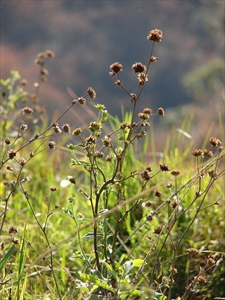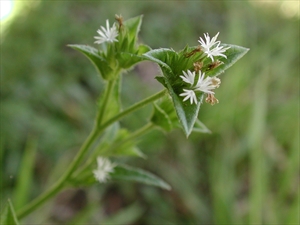Elephant's foot; it is also known as tobacco weed.
Pacific Pests, Pathogens, Weeds & Pesticides - Online edition
Pacific Pests, Pathogens, Weeds & Pesticides
Elephant's foot (459)
Elephantopus mollis. Some authorities consider it synonymous with Elephantopus scaber, but others keep them separate, although they are closely related. It is a member of the Asteraceae.
Asia, Africa, North, South and Central America, the Caribbean, Oceania. It is recorded from Australia, Cook Islands, Federated States of Micronesia, Fiji, French Polynesia, Guam, New Caledonia, Northern Mariana Islands, Palau, Papua New Guinea, Solomon Islands, Tonga, Vanuatu, and Wallis & Futuna.
It is native to tropical America and the Caribbean.
A vigorous and aggressive perennial weed that forms dense stands. It is commonly seen in plantations in sunny, dry, disturbed locations, but it is a also a weed of pastures where rainfall is moderate to high. It seeds prolifically and the leaves of the young plants produce a thick ground cover that smothers competitive species. It occurs up to 2000 masl.
A slender fast-growing plant, reaching heights of 0.5-1.5 m (Photo 1). It begins as a rosette of leaves, each one up to 30 cm long and 10 cm wide, densely covered with hairs on the underside which is also sticky (Photo 2). One or more flowering stems grow from each rosette; these stems too produce leaves, which are smaller (10-20 cm long and 2-5 cm wide) than the rosette leaves, alternate along the stems, have saw-tooth-like margins, and leaf stalks that are winged. The stems have abundant soft hairs, they branch towards their ends, and bear flowers at the end of each branch. The white flowerheads are up to 2 cm wide, produced in clusters with a pair of leaf-like structures (bracts) beneath them (Photos 3&4). The seeds are black, about 3 mm long, and have fine straight bristles, which cling to fur and clothing, and aid spread by wind. The seeds remain viable for 1-2 years only.
Spread is by seeds in wind, water, soil on vehicles, and on animals and clothing. Long distance spread has occurred for use as an ornamental, and as an ingredient in traditional medicines. It has been spread as a contaminant of pasture seeds.
Elephant's foot is the cause of economic and environmental impacts. In the Pacific it is a serious weed of many crops, and in Australia a weed of pastures, especially in Queensland. Pasture species are smothered at a young stage by its rosettes of leaves, and it is unpalatable to stock. It is also recorded as a threat to native species, palms in particular in Hawaii. The spines on the stems cause irritations making hand-weeding uncomfortable. There appears to be no documentation of losses due to the weed.
There are a number of uses recorded: it has been used as an ornamental plant, and for a wide range of medicinal purposes in Africa, Asia and South America. It is also of interest to the pharmaceutical industry for the treatment of cancer, type 2 diabetes and other conditions.
BIOSECURITY
The risk of introduction is thought to be moderate. However, countries not yet infested should consider all likely pathways for entry, and apply quarantine measures accordingly. Particular attention should be given to the risks associated with the weed as a contaminant of pasture seeds, and, perhaps, its use as a medicinal or ornamental plant.
Elephantopus mollis is on the Global Invasive Species Database (2020) of information about alien and invasive species that negatively impact biodiversity, managed by the Invasive Species Specialist Group of the IUCN Species Survival Commission. Elephant's foot is among the 10 most important weeds of Vanuatu, and of considerable importance in French Polynesia, Guam, Solomon Islands, and Tonga. It is a noxious weed in Fiji - prohibited plant that must be controlled - they serve no economic purpose and possess characteristics that are harmful to humans, animals or the environment.
BIOCONTROL
A seed-infesting tephritid fly, Tetreuaresta obscuriventris, was introduced from Trinidad to Fiji and from there to Hawaii. In Fiji, the fly was common on the flower heads throughout Viti Levu. There is no evidence that it has had a significant effect. Waterhouse & Norris suggest other agents should be sought from tropical America.
CULTURAL CONTROL
- Physical & Mechanical
- Hoeing. Where infestations are small, this is the most effective method as regrowth is not a problem.
- Ploughing, discing and harrowing. Suitable for larger cropping areas, with the removal of the weeds from surrounding areas to prevent reinfestation.
- Mowing. For larger infestation this methods plus herbicide treatment has had success.
- Hygiene
- Treat vehicles and farm machinery. If moving from areas where the weed occurs to those weed-free, wash to remove soil. This is equally important if the machinery is being imported into a country or moved within a country. Also, ensure seeds are not carried on clothes between infested and 'clean' areas.
CHEMICAL CONTROL
In Australia: fluroxypyr; glyphosate; metsulfuron-methyl; triclopyr + picloram; picloram, are registered (or under permit) for the control of elephant's foot. In other countries: glyphosate or MCPA (Fiji); 2,4-D.
--------------------
Note, EU approval to use glyphosate ends in December 2022; its use after that date is under discussion.
____________________
When using a pesticide, always wear protective clothing and follow the instructions on the product label, such as dosage, timing of application, and pre-harvest interval. Recommendations will vary with the crop and system of cultivation. Expert advice on the most appropriate herbicides to use should always be sought from local agricultural authorities.
AUTHORS Grahame Jackson & Aradhana Deesh
Adapted from Elephant's foot (Elephantopus mollis) (2018) Weeds of SE Qld and Northern NSW. Lucidcentral. (https://www.lucidcentral.org/editors-pick-animal-and-plant-identification-keys/key-to-weeds-of-se-qld-and-northern-nsw); and additional information from CABI (2019) Elephantopus mollis (elephant's foot). Invasive Species Compendium. (https://www.cabi.org/isc/datasheet/41496#tosummaryOfInvasiveness); and Waterhouse DF, Norris KR (1987) Elephantopus scaber Linnaeus. Biological Control Pacific Prospects. Inkata Press, Melbourne. and from CHAH (2020) Elephantopus mollis Kunth Elephant's foot. Department of Sustainability, Environment, Water, Population and Communities. (https://profiles.ala.org.au/opus/weeds-australia/profile/Elephantopus%20mollis). Photo 1 Forest & Kim Starr. Starr Environmental, bugwood.org. Photo 2 Vinayaraj Elephantopus_scaber. Photo 3 Gerald McCormack, Cook Islands Biodiversity & Natural Heritage. (http://cookislands.bishopmuseum.org/). Photo 4 OM Montiel Close-up of the flowerhead.
Produced with support from the Australian Centre for International Agricultural Research under project HORT/2016/185: Responding to emerging pest and disease threats to horticulture in the Pacific islands, implemented by the University of Queensland, in association with the Pacific Community and Koronivia Research Station, Ministry of Agriculture, Fiji.







